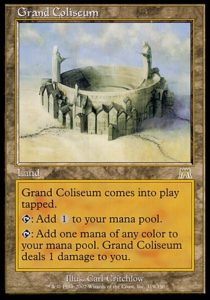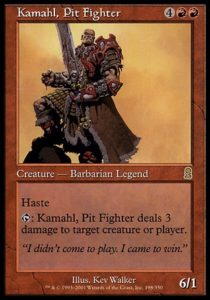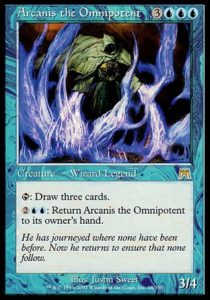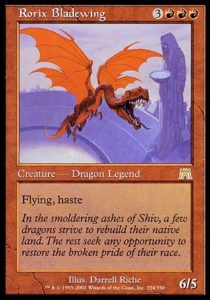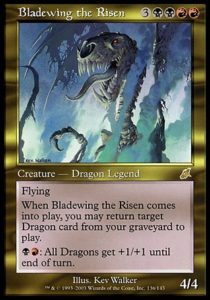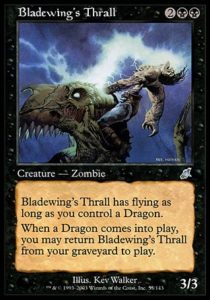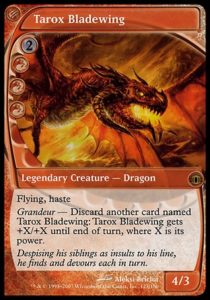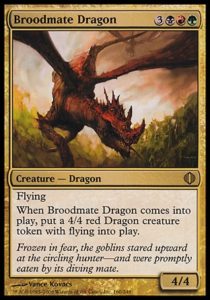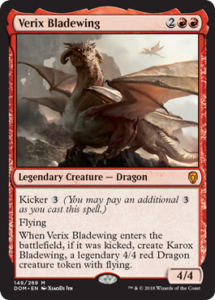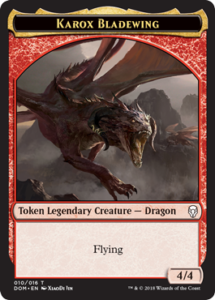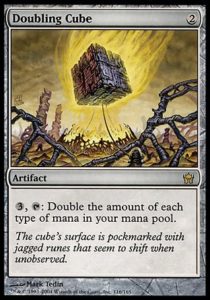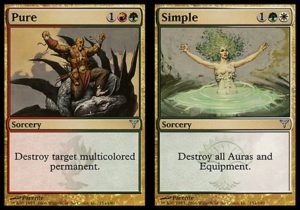Once upon a time, there was a coliseum in Otaria.
Within this coliseum were pit fighters.
Some of these pit fighters were renowned champions, exemplars who awed teeming crowds.
One of these pit champions was a mighty, hasty, and ambitious dragon.
This dragon died and was reborn as an undead, firebreathing behemoth still dedicated to the glory of its kind.
This zombie dragon had a zombie friend. This is an important fact the historians might not tell you. Friends are important.
Much later, this dragon’s brood birthed another mighty Bladewing. Unlike Rorix, he did not play nicely with other dragons or make friends. Instead, he ate them.
Many dragons have trouble making friends. However, even in the volcanic wastelands of Jund, there are dragons who are good at making friends. Friends are indeed important.
Sometimes, old dragon clans can learn new tricks, like the value of friendship.
Verix is a different breed of Bladewing, one who recognizes that sometimes you need to be alone and other times, you’re better off with a friend.
Verix & Karox Bladewing
Before talking about Verix Bladewing, I’d like to take a gander at Karox Bladewing. That legendary token frame looks beautiful. Just look at that golden, legendary name box! No one’s mistaking Karox for a non-legendary, run-of-the-mill dragon. Its aggressive charge provides a nice contrast to Karox’s more regal, relaxed pose. It’s really nice when something as simple as a token with a single (extremely common) keyword ability can have so much cool stuff going for it.
As for Verix Bladewing, I could talk about its potential in Standard—it’s less impressive than Rekindling Phoenix or Glorybringer and lacks the efficiency of Broodmate Dragon, but it may make up for it in the flexibility of being both a four drop and a seven drop. Fortunately, one of the greatest players in history has already weighed in on this. Check out Paulo Vitor Damo da Rosa’s article for his take on Verix in Standard.
I could talk about Verix Bladewing in Limited, but let’s be honest—it’s a mythic rare dragon that doesn’t cost 7+ mana except when you want it to. Verix is amazing and will dominate in Draft and Sealed.
Instead, I’ll talk about a format that I know way better than I do Standard: Cube.
Can Verix make the Cut?
Verix Bladewing is an interesting option for cubes. It’s not good enough to put into a cube for mono red’s sake—it compares poorly to Hellrider (which is king in monored), Hazoret the Fervent (a crazy powerful threat), and Pia and Kiran Nalaar (a powerful value card in both control and aggro), and it’s not as though monored is reliant on or wanting for four drops. It’s worse than Thunderbreak Regent in aggro/tempo and less efficient than Broodmate Dragon in ramp and goodstuff.
I don’t expect Verix Bladewing to be an all-star in traditional Legacy or Vintage Cubes—there are just more powerful, more focused, and more efficient options. A non-hasty four mana 4/4 just doesn’t cut the mustard in formats where you can die to Splinter Twin or your opponent is likely to answer it with a Doom Blade or Flametongue Kavu. Sure, Verix can be a fine inclusion in ramp, since a 4/4 for 4 plays solid defense if your ramp deck sputters out, but I’m not confident the utility of Air Elemental/Broodmate Dragon is better than the raw power of a Huntmaster of the Fells or Dragonlord Atarka.
In less powerful cubes like mine and more offbeat cubes, Verix can make a huge splash. Verix pressures planeswalkers, can beat 1-for-1 removal, is a good draw at most stages of the game, and can even help support a historic (or minor dragon) theme (because you’ve not lived until your Thunderbreak Regent punishes your opponent for trying to take out your Tauren Mauler).
Verix Bladewing is definitely worth trying out in cube. I’m happy to be wrong about the card—heck, I’ve been impressed by Thunderbreak Regent and many decks don’t benefit much from its Lava Spike clause. Perhaps Verix has all it needs to make a splash even in Legacy Cube.
Good, Clean Design
Verix Bladewing is a fantastic example of elegant design. It’s a simple split card: either you get one 4/4 flying dragon or two. You get something great or two great things (and, as mathematics dictates, great + great = amazing).
Verix presents an interesting choice: get value immediately or wait for full value. It allows players to be greedy and be rewarded or punished based on their skill at analyzing the game state. There’s a great story about Mark Rosewater playing a deck with with four Grizzly Bears in an internal WotC league. He went 4-0, winning the week’s league, and was only then informed that his bears were in fact proxies for Kavu Titan. The next week, he went 2-2—he played worse because he wasn’t playing his Kavu Titans on curve. The third week, he would only kick his Kavu Titans if he didn’t have other options, and again he went 4-0. Simple designs like Kavu Titan and Verix Bladewing can nevertheless provide ample opportunity for skillful play.
Verix manages to hearken back to five different cards (three Bladewings, Bladewing`s Thrall, and Broodmate Dragon) using only its name and the gist of its ability. That’s a whole lot of nuance to a card that basically reads: 4/4 dragon, kicker: 4/4 dragon.
And that, my friends, is Verix Bladewing. Thank you kindly for participating in my first preview article (hopefully the first of many) and to WotC for graciously giving me this wondrously elegant design to spoil. And, as always, thanks for reading.
—Zachary Barash
Zachary Barash is a New York City-based game designer. He works for Kingdom Death: Monster, has a Game Design MFA from the NYU Game Center, and does freelance game design. When the stars align, he streams Magic.
His favorite card of the month is Skymark Roc. It’s painfully good when played on curve but isn’t unbeatable. It even tells a nice little story—it delivers your opponent a present as its clawing at their eyes.

